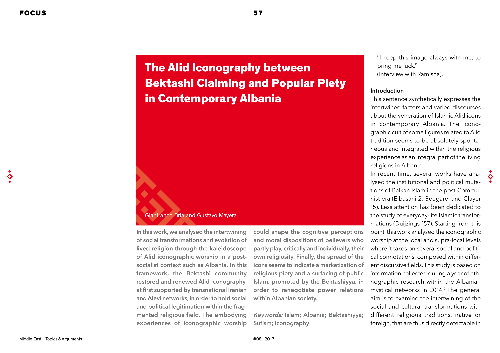The Alide Iconography between Theological Debate and Popular Piety in Contemporary Albania
In this work, we analysed the intertwining of social transformations and evolution of lived religion through the kaleidoscope of Alid iconographic worship in a postsocialist context such as Albania. In this framework, the Bektashi community restored and renewed Alid iconography, at first supported b...
Đã lưu trong:
| Xuất bản năm: | Middle East - Topics & Arguments |
|---|---|
| Những tác giả chính: | , |
| Định dạng: | Artikel (Zeitschrift) |
| Ngôn ngữ: | Tiếng Anh |
| Được phát hành: |
Philipps-Universität Marburg
2017
|
| Những chủ đề: | |
| Truy cập trực tuyến: | Truy cập trực tuyến |
| Các nhãn: |
Không có thẻ, Là người đầu tiên thẻ bản ghi này!
|
| Tóm tắt: | In this work, we analysed the intertwining of social transformations and evolution of lived religion through the kaleidoscope of Alid iconographic worship in a postsocialist context such as Albania. In this framework, the Bektashi community restored and renewed Alid iconography, at first supported by transnational Iranian and Alevi networks, in order to hold social and political legitimation within the fragmented religious field. The embodying experiences of iconographic worship could shape the cognitive perceptions and moral dispositions of believers who partly play, critically and individually, their own religiosity. Finally, the spread of the icons seems to indicate a marketization of religious piety and a surfacing of public Islam, promoted by the Bektashiyya, in order to renegotiate power relations within Albanian society. |
|---|---|
| DOI: | 10.17192/meta.2017.8.6080 |
